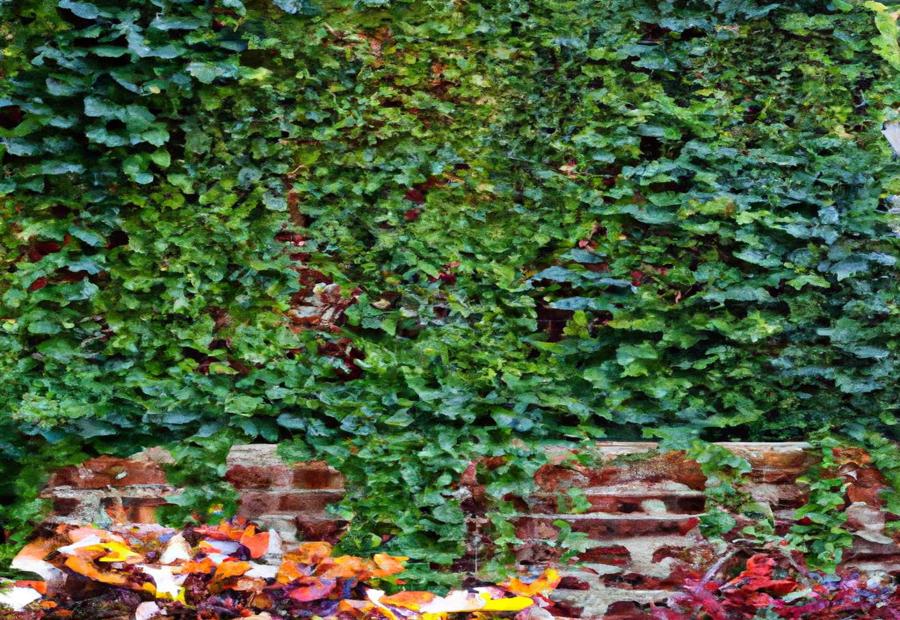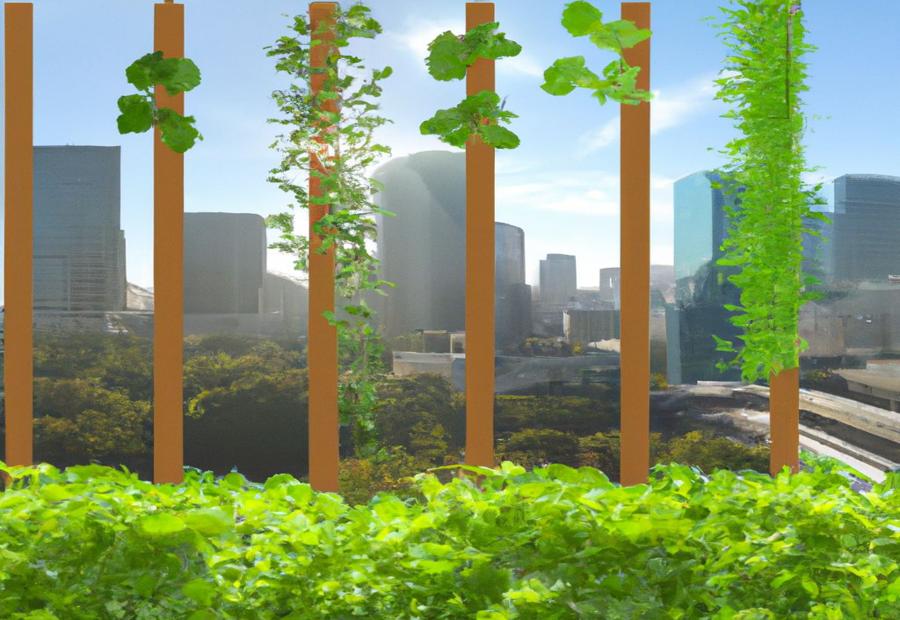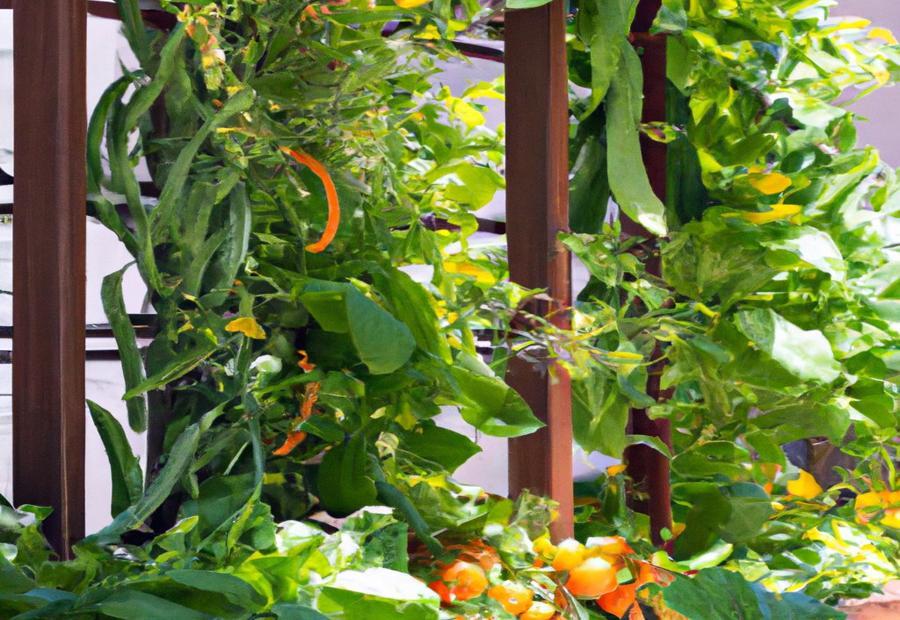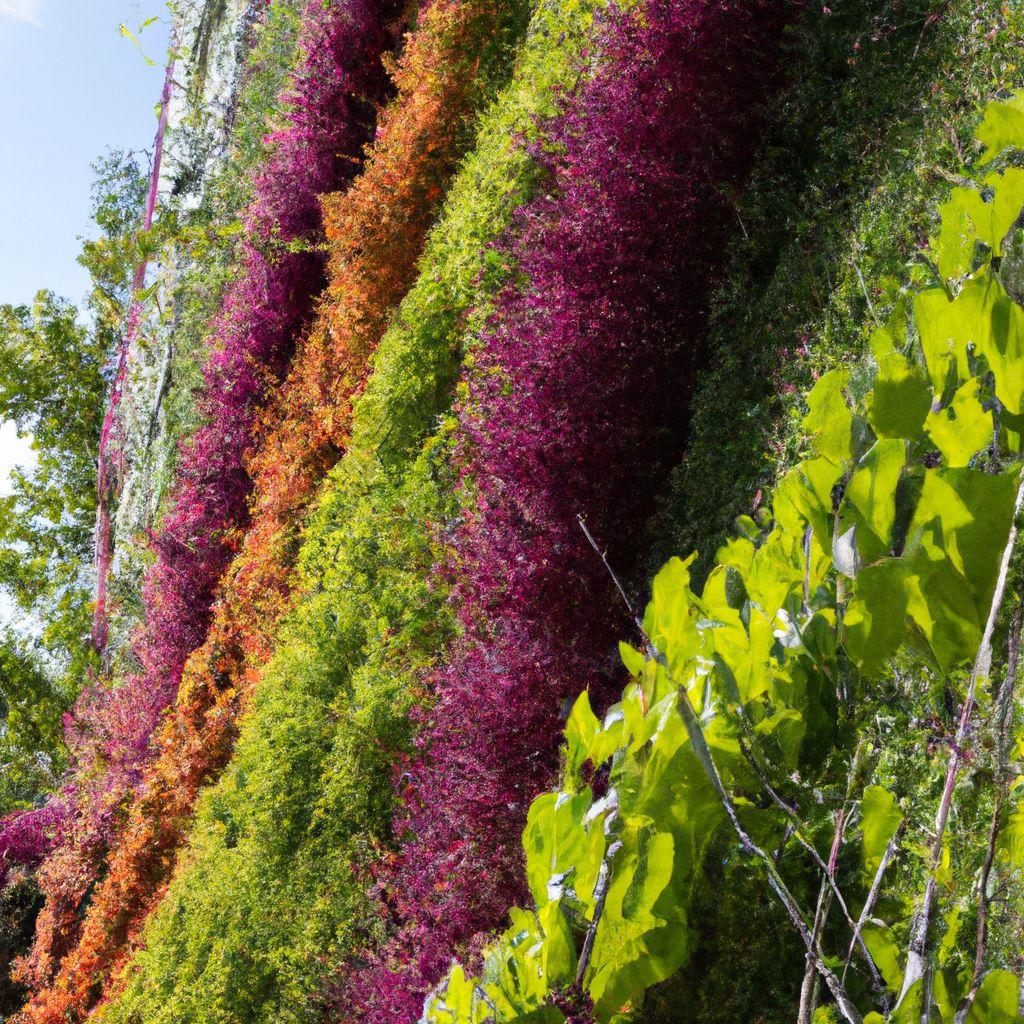Key Takeaway:
- Vertical gardens maximize growing space: By utilizing vertical structures, such as trellises and supports, climbers and vining plants can be grown in containers and limited gardening spaces, maximizing the available area for gardening.
- Climbing and vining plants offer versatility: Climbers include a wide range of plants, such as shrubs, vines, flowers, vegetables, fruits, and houseplants. This variety allows gardeners to create diverse and visually appealing vertical gardens.
- Proper support and care are essential: Providing sturdy supports for thick vines and large vegetables, as well as lighter weight supports for annual vines and vining houseplants, ensures that the plants are well-supported and can grow optimally. Additionally, assisting vines that require additional support, such as using VELCRO® Brand Garden Ties, helps maintain their growth.
- Vertical gardening with vegetables offers numerous benefits: Growing vegetables vertically on trellises not only maximizes space but also improves air circulation around the plants and facilitates easier harvesting and maintenance. Different types of trellises and suitable crops, such as bamboo trellises with netting or twine and grasping vegetables like peas and pole beans, offer various options for vertical gardening with vegetables.
- Fast-growing climbing plants provide quick coverage: Fast-growing climbing plants, including both evergreen and deciduous vines, can quickly cover vertical structures. There are different methods of climbing and support, and controlling the growth of these plants may be necessary. The top 10 fast-growing climbing plants for screening and privacy purposes offer stunning visual results.
Introduction

Photo Credits: Gardeninggurus.Org by Samuel Flores
Maximizing growing space with vertical gardens can revolutionize your gardening experience. Discover how this innovative technique allows you to cultivate climbers and vining plants while optimizing limited areas. Learn about the benefits and techniques of vertical gardening, and unleash the potential of your outdoor or indoor spaces. With a deeper understanding of this approach, you can create a lush and vibrant oasis that defies traditional gardening limitations.
Maximizing Growing Space with Vertical Gardens
Vertical gardening is the best way to make the most of limited space! Climbing and vining plants like shrubs, flowers, veggies, fruits, and houseplants can help you give those extra inches. You must consider the sunlight needs of each plant when choosing where to go.
Here’s a 6-step guide for maximizing growing space with vertical gardens:
- Pick the right container size for your garden.
- Add nutrient-rich soil, compost, and fertilizer to provide vital elements for growth.
- Use sturdy supports for thick vines and big veggies to avoid damage.
- Try lighter supports for annual vines, perennial vines, and vining houseplants.
- Use VELCRO® Brand Garden Ties for extra support for heavy vines.
- Move container plants indoors for maintenance during cold months.
The type of trellis will depend on the crop. Peas and pole beans can climb a bamboo trellis with netting or twine. Tomatoes, cucumbers, melons, and gourds can also be trellised. Ready to reach new heights? Vertical gardens will bring you abundant harvests and lush greenery!
Benefits of Using Climbing and Vining Plants

Photo Credits: Gardeninggurus.Org by Joseph Sanchez
Discover the endless benefits of incorporating climbing and vining plants into your garden. From optimizing limited gardening spaces to the wide variety of plants you can choose, including shrubs, flowers, vegetables, fruits, and even houseplants, there are numerous advantages to embracing these natural climbers. Additionally, finding the perfect match between plants and their required sunlight conditions will ensure a thriving vertical garden. Get ready to transform your space with these versatile and visually appealing green wonders!
Ideal for Container and Limited Gardening Space
Vertical gardens are perfect for those with limited or container gardening space. They utilize walls and trellises to support growing plants, allowing gardeners to get creative with their selection. From shrubs and vines to flowers, vegetables, fruits, and even houseplants, these gardens maximize growing space and provide an efficient, aesthetic solution. Plus, lightweight supports can be used to make maintenance tasks such as pruning or harvesting easier while keeping the garden stable. So, get ready to take advantage of vertical space and make your garden dreams come true!
Climbers Can Include Shrubs, Vines, Flowers, Vegetables, Fruits, and Houseplants
Climbing plants provide a plentiful range of options to maximize growing space and create stunning landscapes. Shrubs, vines, flowers, vegetables, fruits, and houseplants can all be included in vertical gardening. Climbing plants can be trained on trellises or other structures as they reach for the sun. Plus, they offer convenience when it comes to harvesting.
Vertical gardening is like a match-making process; make sure your plants get along! Viveka Neveln states that climbing plants offer an innovative solution for utilizing both horizontal and vertical space. So, explore the possibilities and bring a unique environment that caters to your gardening needs.
Considering Sunlight Requirements When Matching the Right Plant with the Right Location
When selecting plants, it’s essential to consider sunlight needs. Different plants have varying requirements for exposure. Choose plants that can thrive in the available light of the given location.
Maximize gardening space with climbing and vining plants. These offer lots of benefits. Examples include shrubs, vines, flowers, vegetables, fruits, and even houseplants. They can be grown in containers or beds, ideal for vertical gardens. Make sure the plants’ sunlight needs match the available light in their spot.
Creating the right growing environment involves several factors. Consider the right container or bed size and provide soil, compost, and fertilizer for optimal growth. For thick vines and large vegetables, sturdy supports are essential. VELCRO® Brand Garden Ties are helpful for annual vines, perennial vines, and vining houseplants.
Creating the Perfect Growing Environment

Photo Credits: Gardeninggurus.Org by Bradley Nelson
When it comes to creating the perfect growing environment for climbers and vining plants, there are several key factors to consider. From choosing the right container or bed size to providing sturdy supports, this section will explore the essential elements that contribute to successful growth. We’ll discuss the importance of soil, compost, and fertilizer, as well as selecting the appropriate supports for different types of vines. Additionally, we’ll explore how VELCRO® Brand Garden Ties can assist in providing additional support for specific vines.
Choosing the Right Container or Bed Size
When selecting the perfect container or bed size for vertical gardening, it’s essential to consider the mature size of the plant, the root system depth, the spacing between plants, and any unique details that could affect growth.
For vining plants like peas and pole beans, pick a trellis with adequate height and width. If using a raised bed, be sure to check its length too – longer beds have more planting space, but may need additional supports for larger vines.
Gardeners in the past faced difficulties when it came to determining the right container or bed size. But, as vertical gardening became more popular, experts developed guidelines to help maximize the growing space. Now, gardeners have the knowledge to create an ideal growing environment for their plants!
Lastly, don’t forget to get your dirt on with the right ingredients: soil, compost, and fertilizer. Your plants will thank you!
Key Elements for Growth: Soil, Compost, and Fertilizer
Soil, compost, and fertilizer are important for plants to survive in vertical gardens. They give essential nutrients and help. Choose the right soil for success. It should have good drainage and organic matter. Mix garden soil, compost, and perlite for best results.
Compost adds structure, water-holding capacity, and nutrients to soil. Organic matter boosts plant growth. Make compost from kitchen scraps, yard waste, or manure.
Vertical gardens need regular fertilization. Slow-release fertilizers supply nutrients over time. Use liquid fertilizers during growing season too.
Monitor plant health. Address any issues quickly. With soil, compost, and fertilizer, vertical gardens yield bountiful harvests!
Secure plants with supports as strong as the Hulk on leg day! Don’t let veggies suffer a catastrophe!
Providing Sturdy Supports for Thick Vines and Large Vegetables
In a beautiful countryside garden, thick vines abounded with luscious tomatoes. The gardener chose strong wooden stakes for each plant and secured them with soft ties. As summer progressed, the vines grew thicker and heavier, yet the supports held strong, helping the tomatoes reach their full potential. This showed the importance of providing sturdy supports for thick vines and large vegetables.
Gardeners must select the right support structure for thick vines and big vegetables. Materials such as wooden stakes, metal trellises, or wire cages work best. They should be strong enough to hold the weight without damage.
Secure the plants with ties or clips that won’t harm stems or leaves. They should be tight, but not so tight that it restricts growth.
As the plants grow, check on them and make modifications, such as adding stakes, tying up loose branches, or adjusting ties as needed. This helps maximize growing space and achieve healthy growth.
Each plant requires different support, so consider the specific needs. Regular monitoring and adjustments can prevent potential damage or instability.
Make sure to give your vertical stars some TLC with lightweight supports!
Selecting Lighter Weight Supports for Annual Vines, Perennial Vines, and Vining Houseplants
When it comes to annual vines, perennial vines, and vining houseplants, lighter weight supports are essential for stability and growth. Several options are available to consider.
Bamboo trellises with netting or twine are ideal for these plants, providing lightweight yet sturdy support. Peas and pole beans have grasping structures that can be wrapped around lighter weight supports. These need to be strong enough to hold the weight of the plants but flexible enough for them to attach securely.
For vegetables with heavy fruits, cages or stakes are recommended. These should be able to bear the weight while staying stable.
Vining houseplants require gentle support that won’t put excessive strain on the plant. Moss poles or decorative trellises are good choices.
Using lighter weight supports in vertical gardening has many benefits, such as maximizing growing space and efficient resource use. Viveka Neveln, a gardening expert, approves of this method.
Sometimes extra support is needed, and VELCRO® Brand Garden Ties can do the job. They give strong yet flexible additional help to ensure plants’ success.
In conclusion, choosing lighter weight supports for these plants is essential. Trellises, netting, grasping structures, and specific support methods can make them thrive without damage.
Assisting Vines that Require Additional Support: Using VELCRO® Brand Garden Ties
When creating your vertical garden, it is essential to pick the correct vines. Think about their growth and support needs. Some have delicate stems that might need extra help to keep them from breaking or bending. VELCRO® Brand Garden Ties are perfect for this. They can be easily wrapped around stems and securely attached to trellises.
Guide the vines along the trellis or structure. Use VELCRO® Brand Garden Ties to secure any loose branches or stems, so the wind won’t damage them. Prune the vines for the desired shape and to let the sun and air in. Monitor the progress, and adjust the ties as needed. Move or extend the support as the climbers get taller.
Tension is important when using VELCRO® Brand Garden Ties. They should provide support, but not restrict the natural growth of the vines. Don’t overtighten, as this could harm them.
VELCRO® Brand Garden Ties are an excellent choice for supporting your vertical garden. They are adjustable, and you can reposition or remove them without leaving residue. They are also weather-resistant, so they will last.
You can also consider other methods like trellises, stakes, or cages made of materials like bamboo or metal. However, VELCRO® Brand Garden Ties offer a unique solution without damaging or restricting the vines.
In conclusion, giving your vines the right support is key for your vertical garden to flourish. With the right support, your climbing plants will create a stunning display.
Seasonal Considerations and Care

Photo Credits: Gardeninggurus.Org by Jerry Hernandez
As we explore the seasonal considerations and care for vertical gardens, we will uncover helpful strategies for dealing with fall and winter challenges that affect different types of climbers and vining plants. Additionally, we’ll discuss the importance of ensuring winter survival by properly moving container plants. By understanding the unique needs of these plants during colder months, we can maintain thriving vertical gardens all year round.
Dealing with Fall and Winter: Annual Vines, Perennial Vines, and Woody Vines
Caring for annual vines, perennial vines, and woody vines during fall and winter is essential. Knowing their unique needs can help ensure their survival. For example, providing blankets and tarps for frosty nights, moving container plants indoors, mulching around the bases, and monitoring moisture levels. Support structures like trellises and stakes can help prevent breakage from heavy snow and wind.
It’s important to tailor care according to each vine type’s characteristics. Pruning can help manage size and appearance, and promote healthy new growth. Guidelines should be followed for each vine type.
Beware of potential risks – some annual vines have seed pods with alkaloids that can be toxic if ingested. Take precautions when handling or disposing of these plants.
Ensuring Winter Survival: Moving Container Plants
Winter is crucial for the survival of container plants. So, to ensure their well-being, provide them with the right care. This includes understanding what each plant needs and providing suitable conditions.
To move container plants successfully during winter, follow this 5-step guide:
- Prepare beforehand: Plan ahead of the first frost. Prioritize plants vulnerable to cold.
- Choose proper containers: Lightweight but strong. Use pots with wheels for easier movement. Make sure they have drainage holes.
- Protect root systems: Loosen the soil around the root ball. Do it carefully to avoid damage.
- Provide adequate light and temperature: Place near south-facing window. Make sure the temperature suits each species.
- Adjust watering schedule: Water less due to slower growth. Monitor soil moisture regularly. Don’t overwater.
Different plants have different requirements for temperature, humidity, and sunlight. Research each plant’s needs and adjust your care accordingly.
Gardeners used to face difficulties in preserving container plants during winter. Now, we can provide better care and protect them from cold months. With these guidelines and understanding each plant’s needs, you can successfully move and protect your container plants.
Vertical Garden Plant Recommendations

Photo Credits: Gardeninggurus.Org by Richard Smith
Discover an extensive lineup of vertical garden plant recommendations by Viveka Neveln. From climbers to vining plants, this section provides a comprehensive list of options to transform your vertical garden into a flourishing oasis. Get ready to explore a diverse range of plant species perfectly suited for vertical gardening, ensuring an enchanting display of greenery and vibrant colors. Let’s delve into the world of vertical gardening possibilities and unleash your creativity in nurturing these botanical wonders.
A Comprehensive List of Vertical Garden Plants by Viveka Neveln
Gardening at the vertical level? Look no further than the Comprehensive List of Vertical Garden Plants by Viveka Neveln! This list offers a variety of options, such as shrubs, vines, flowers, vegetables, fruits, and houseplants. Each plant is carefully chosen to consider sunlight needs and the best location for growth. Plus, it provides helpful info on the recommended container or bed size for each.
The list stands out with its detail on the specific needs of each plant. This means gardeners can pick a diverse selection of climbing and vining plants that will thrive in their vertical spaces. So, let’s get growing! Explore the list and plan your vertical garden today!
Vertical Gardening with Vegetables

Photo Credits: Gardeninggurus.Org by Kenneth Williams
Vertical gardening with vegetables offers numerous benefits and opens up a world of possibilities. Discover the advantages of growing vegetables vertically on trellises and explore the different types of trellises available. Find out which crops thrive in this innovative gardening approach and elevate your gardening experience to new heights.
Benefits of Growing Vegetables Vertically on Trellises
Benefits of Growing Vegetables Vertically on Trellises:
- Maximize gardening space.
- Ideal for container and limited gardening space.
- Wide range of options, including shrubs, vines, flowers, vegetables, fruits, and houseplants.
- Increased air circulation prevents diseases and promotes healthy plant growth.
- Easier pest control.
- Greater accessibility during all stages of cultivation.
- Helps prevent soil erosion and reduces weed growth.
- Enjoy a bountiful harvest in even the smallest of spaces.
Considering the sunlight requirements when matching the right plant with the right location is crucial to ensure proper growth and yield.
Types of Trellises and Suitable Crops
Vertical gardening is a unique way to maximize growing space. This is done by using climbing and vining plants. These plants are great for small areas, as they can be trained to grow up, saving ground space. Shrubs, vines, flowers, veggies, fruits, and even houseplants can be used. When selecting the right plant, it is important to consider sunlight needs and match it with the right spot.
For climbers and vining plants, several elements need to be taken into account. Selecting the right container or bed size is essential. Also, strong supports are needed for thick vines and large vegetables. Lighter weight supports are ideal for annual and perennial vines, as well as vining houseplants. VELCRO® Brand Garden Ties can help out vines that need extra support.
Seasonal care and attention must be given to climbers and vining plants in fall and winter. Annual, perennial, and woody vines may need extra protection or pruning. Container plants may need to be moved indoors or provided with insulation.
Trellises are perfect for different crops in vertical gardening. Bamboo trellises with netting or twine can make a sturdy structure for veggies. Peas and pole beans have grasping structures and easily cling onto trellises. Tomatoes, cucumbers, melons, and gourds can also benefit from various methods of support. Refer to the table below for more info on trellises and their corresponding crops:
| Types of Trellises | Suitable Crops |
|---|---|
| Bamboo trellises with netting or twine | Various vegetables |
| Grasping structures | Peas and pole beans |
| Traditional trellises | Tomatoes, cucumbers, melons, gourds |
Remember, this is just a summary. There may be other options based on specific gardening needs and preferences.
If you use vertical gardening techniques and the right trellises for different crops, you can maximize your growing space and create a flourishing garden. Try vertical gardening today and take advantage of the many benefits of climbers and vining plants!
Bamboo Trellises with Netting or Twine
Bamboo trellises with netting or twine are a great choice for vertical gardening. These trellises offer a sturdy and natural structure for climbing plants. The strength of bamboo lets it support heavy foliage and produce. Netting or twine can be used to weave patterns which help guide the plants as they climb. This prevents tangling and encourages healthy growth. Plus, bamboo is flexible, so you can customize the trellis’s size for your gardening needs.
Using bamboo trellises with netting or twine offers several advantages. Firstly, you can make use of vertical surfaces that would otherwise be unused. This is especially helpful for container gardens or limited spaces. By growing climbers like shrubs, vines, flowers, vegetables, fruits, and even houseplants, you can maximize the space. Secondly, the trellises increase air circulation and sunlight exposure, compared to traditional ground-level gardening methods. This helps with photosynthesis and growth.
To get the most out of the trellis, consider the sunlight needs of the plants. Some prefer full sun while others prefer partial shade. Place each plant on the trellis according to its light needs, so it gets maximum exposure without overcrowding.
In the end, bamboo trellises with netting or twine are ideal for vertical gardens. They are versatile, encouraging healthy growth with proper support and sunlight. Incorporating these trellises into your gardening practices can create a thriving vertical garden that uses space efficiently and looks great. Peas and pole beans are natural climbers, so they are perfect for vertical gardening.
Vegetables with Grasping Structures: Peas and Pole Beans
Veggies with special climbing structures, like peas and pole beans, are great for vertical gardening! They can attach themselves to support structures, using up minimal space. This makes them ideal for trellises and other vertical supports. Let’s check out some examples:
| Vegetable | Climbing Mechanism |
| Peas | Tendrils that wrap around supports |
| Pole Beans | Vines that twine around poles or trellises |
Peas have tendrils that wrap around supports, while pole beans have vines that twine around poles or trellises. So, they can both thrive growing vertically. However, each veggie has its own unique growth patterns and planting requirements.
Treat your vegetables to a trellis lift! Tomatoes, cucumbers, melons and gourds can all benefit from vertical gardening.
Trellising Tomatoes, Cucumbers, Melons, and Gourds
Choose the right trellis for your plants! Bamboo trellises with netting or twine are popular for tomato, cucumber, melon, and gourd plants.
When planting, start near the base of the trellis for best results.
As the plants grow, guide the vines up and secure them to the trellis using garden ties.
Remember to prune side shoots and suckers to focus energy towards fruit production.
Pick the fruits carefully from the vine to prevent damage while trellising.
Seasonal changes can affect the plants, so move container plants indoors during fall and winter.
It’s important to consider each plant’s characteristics when choosing a trellis design and training method. Regularly inspect and maintain the structure, reinforcing any weak points and adjusting ties as needed. This will ensure optimal support for vertical growth and prevent damage to both plants and trellis.
10 Vegetables That Thrive in Vertical Gardening

Photo Credits: Gardeninggurus.Org by Sean Lopez
Vertical gardening offers a unique way to maximize space and grow a variety of vegetables. In this section, we will explore 10 vegetables that thrive in vertical gardening. From peas and tomatoes to cucumbers and winter squash, each sub-section will showcase the benefits and techniques for successfully cultivating these plants in a vertical garden. So, if you’re looking to make the most of your vertical space, read on to discover which vegetables are perfect for your climbing and vining garden.
Peas
Peas are an amazing choice for vertical gardens! They have tendrils that let them climb and grow upwards, and they’re perfect for trellises made of bamboo or netting. Peas make great use of space and also produce delicious pods that can be harvested when young and tender. Plus, they are nitrogen-fixing plants – so they enrich the soil around them.
Plus, peas come in various varieties, like snow and snap peas. Each kind has its own flavor and characteristics. And, they can be planted in both spring and fall! With these versatile veggies, you can get a good harvest when growing vertically.
A gardener had a great experience with vertical gardening. They were able to save loads of space by using a trellis. The pea plants grew skywards and produced plenty of delicious, sweet and crisp pods. This vertical garden was both attractive and productive – it provided fresh peas without taking up much ground space.
Go higher and higher with vining and climbing plants! Make those tomatoes envious with your pea-growing skills!
Tomatoes
Table below shows fast-growing climbing plants great for vertical gardening with tomatoes.
| Plant | Type | Sunlight Requirement | Growth Rate |
|---|---|---|---|
| Peas | Annual | Full sun | Fast-growing |
| Pole Beans | Annual | Full sun | Fast-growing |
| Cucumbers | Annual | Full sun | Fast-growing |
| Melons | Annual | Full sun | Fast-growing |
| Tomatillos | Annual | Full sun | Fast-growing |
Tomatoes are perfect for vertical gardening. They have grasping structures that can be trellised with bamboo and netting or twine for support. Going vertical helps save space and increases air circulation, reducing risk of diseases and pests. It also makes pruning, harvesting and maintenance easier.
Vertically-grown tomatoes add beauty to your garden. Combine them with other climbers and vining plants for a stunning display. With proper care, you’ll get to enjoy a delicious harvest.
Loofah
Loofah is perfect for making the most of your growing space. Its grasping structures let it climb and vine easily. Plus, these fast-growing plants provide great privacy and screening. They work well in annual or perennial gardens. And, best of all, loofahs are low-maintenance. You can even harvest them for their fibrous interior, which can be used as natural sponges or exfoliators!
Melons
For a summary of melons in vertical gardening, let’s look at this table:
| Melon Variety | Description |
|---|---|
| Watermelon | Juicy and refreshing. Needs sturdy supports, like trellises or strong fences. |
| Cantaloupe | Sweet aroma and soft texture. Can attach to trellises or bamboo poles with netting. |
| Honeydew | Smooth, pale green skin and sweet taste. Needs trellises or other support structures. |
Plus, there are other types of melons like muskmelons, casaba melons, and Persian melons. These can also be grown vertically.
For melons, full sun exposure is important. 6 hours a day is best for optimal yields. Ensure that your vertical garden setup provides enough sunlight for these plants.
Now, for the history: Melons have been cultivated for thousands of years. Ancient Egyptians were growing them back in 2400 BC. Melon seeds were even found in Egyptian tombs.
Through the ages, people have grown and appreciated melons. With vertical gardening, it’s easier and more efficient. Maximize your space and enjoy the abundance of these delicious fruits!
Tomatillos
Tomatillos are a special veg that love vertical gardening. They’re perfect for trellising, and their flavor adds something special to dishes.
Tomatillos have many great qualities that make ’em great for vertical gardening. They’re perfect for trellis-growing, which lets ’em maximize garden space. Plus, they offer a unique flavor when harvested and used in recipes. You can even use bamboo trellises with netting or twine for sturdy support. Grow tomatillos vertically and get the best of both worlds – an efficient, attractive garden and a tasty, versatile veg.
Tomatillos are closely associated with Mexican cuisine. Native to Mexico and Central America, they often show up in traditional dishes like salsa verde. Their tartness pairs well with other ingredients, making vibrant, flavorful sauces. They’re popular worldwide for their unique taste and versatility. Use ’em raw in salads or cooked in sauces and stews – they always add a distinctive twist. Delicious and refreshing – that’s what tomatillos are all about!
Yardlong Beans
Yardlong Beans, also known as ‘long beans’, are a special type of climbing plant that can be grown vertically in a garden. They have grasping structures that let them easily climb up trellises and other supports. Their unique feature is the long pods they produce – up to one yard in length – hence their name!
Growing Yardlong Beans in a vertical garden comes with many benefits. It allows you to make the most of the growing area, which is great if you have limited space or prefer container gardening. It also encourages better airflow and sunlight exposure, leading to healthier plants and higher yields.
Despite their vertical growth, Yardlong Beans still need proper care and attention. Rich, well-draining soil, compost, and fertilizer are essential for optimal growth. Plus, they need strong support as their thick vines can become heavy when bearing large vegetables. VELCRO® Brand Garden Ties are great for extra support for annual vines, perennial vines, and vining houseplants.
You might be surprised to know that Yardlong Beans are popular in Asian cuisine, especially Chinese dishes. They are often used in stir-fries and soups due to their unique texture and flavor.
Malabar Spinach
Malabar Spinach is a vining plant that loves full sun to partial shade. It needs well-draining soil and regular watering. Plus, its leaves can be harvested continuously. It has thick succulent leaves with a slightly tangy flavor, making it popular for salads, stir-fries, and soups. It’s also high in vitamins A and C, iron, and calcium.
A passionate gardener transformed their balcony into a vertical garden with trellises, using Malabar Spinach. They maximized their space while harvesting plenty of fresh greens. This success story shows how vertical gardening with Malabar Spinach can be both aesthetically pleasing and practical in urban environments.
And don’t forget: cucumbers are great for your vertical garden, but don’t expect them to call you back.
Cucumbers
Discover the best vertical garden plants! Here’s a table to show different types of climbers and vining plants that are perfect for vertical gardening:
| Types of Climbing Plants | Suitable for |
|---|---|
| Peas | Grasping structures |
| Pole Beans | Grasping structures |
| Tomatoes | Trellising tomatoes, cucumbers, melons, and gourds |
| Cucumbers | Trellising tomatoes, cucumbers, melons, and gourds |
| Melons | Trellising tomatoes, cucumbers, melons, and gourds |
| Tomatillos | Trellising tomatoes, cucumbers, melons,and gourds |
Cucumbers stand out due to their climbing nature. Growing them vertically on trellises, such as those made of bamboo or using netting/twine, allows for healthy growth. Air circulation is also better, preventing disease. Plus, harvesting is simpler since cucumbers are kept off the ground.
Cucamelons
Cucamelons are an amazing addition to any garden. Not just for their ornamental value, but for their tangy flavor too! They require minimal space and are perfect for container or limited gardening areas. Vertical gardening is a great way to utilize these tiny melon-like fruits. With their grasping structures, cucamelons thrive on trellises or netting. This makes them easy to manage and harvest. Plus, they help save on resources like water and sunlight.
When growing cucamelons vertically, you need a sturdy trellis or support system. Bamboo trellises with netting or twine are great for these climbers. They attach themselves to the trellis using tendrils or twining stems. For heavier fruits like tomatoes, cucumbers, melons, and gourds, stronger supports may be needed.
On top of that, cucamelons offer loads of aesthetic value with their attractive foliage and abundant fruiting. Quickly covering vertical spaces, they make an excellent choice for screening and privacy purposes.
Winter Squash
Winter Squash is a type of veggie that grows upwards in a vertical garden. It is popular for this ’cause it can climb up trellises and other supports. Winter Squash plants need sturdy supports to hold the weight of their large fruits. They are typically grown in fall and winter seasons, making them great for colder climates. Butternut squash, acorn squash, and spaghetti squash are some examples of Winter Squash varieties. These veggies have a long shelf life and can be stored for several months after harvest.
Winter Squash has lots of advantages for vertical gardening. Here are some key points:
- Vertical gardening helps you use your space wisely by utilizing trellises or other supports.
- Winter Squash plants have long vines that can be trained up these structures, perfect for vertical growth.
- Growing Winter Squash vertically saves ground space in your garden.
- Supports make sure air circulates around the plants, reducing the risk of disease.
- Vertical gardening with Winter Squash makes harvesting easier, as the fruits are easier to spot and reach.
- Growing Winter Squash vertically can help prevent rotting or damage from pests in the soil.
Winter Squash is a great veggie that offers unique qualities for vertical gardening. Its ability to grow upwards on trellises or other supports lets growers get the most out of their space. Plus, its long shelf life makes it a practical choice for fall and winter storage. By adding Winter Squash to your vertical garden, you get the best of efficient use of space and ease of maintenance.
Fast-Growing Climbing Plants for Vertical Coverage

Photo Credits: Gardeninggurus.Org by Raymond Thompson
When it comes to creating a lush vertical garden, fast-growing climbing plants are the key. In this section, we’ll explore the benefits of these plants and the different types available, from evergreen vines to deciduous vines. We’ll also discuss the various methods of climbing and support, as well as considerations for controlling growth. And if you’re looking to enhance privacy or create a natural screen, we’ve compiled a list of the top 10 fast-growing climbing plants to choose from. Get ready to transform your space with vertical coverage like never before.
Benefits of Fast-Growing Climbing Plants
Fast-growing climbing plants offer many advantages for vertical gardens. They grow quickly, which allows them to cover vertical surfaces in a short amount of time. This fast growth can create privacy and screening, making them perfect for lush green walls or fences. Additionally, these plants can add visual appeal to outdoor spaces, with a vibrant atmosphere.
Plus, these plants can reduce the effects of direct sunlight and heat on buildings. This helps keep temperatures down and lower energy consumption. The dense foliage of these climbers also works as a sound barrier, reducing noise levels in cities.
Moreover, these plants aid environmental sustainability. They take in carbon dioxide and release oxygen through photosynthesis, improving air quality. Their large root systems stop soil erosion and boost water absorption, bettering soil health.
Overall, the advantages of fast-growing climbing plants are many. They can quickly cover vertical spaces, provide privacy and beauty, regulate temperature, and reduce noise pollution. As such, they are a great choice for vertical gardens needing both function and attractiveness.
Types of Fast-Growing Climbing Plants: Evergreen Vines and Deciduous Vines
Climbing plants that grow quickly can be divided into two types: evergreen vines and deciduous vines. These plants are known for their speed and the ability to cover vertical surfaces quickly.
- Evergreen vines stay green all year. They can give walls, trellises, and fences the look of greenery year-round. Some popular examples of evergreen vines are English Ivy, Virginia Creeper, and Climbing Hydrangea.
- Deciduous vines, on the other hand, lose their leaves in winter. They give lush foliage during spring and summer, as well as bright fall colors before becoming dormant in winter. Popular deciduous vines include Boston Ivy, Wisteria, and Trumpet Vine.
These fast-growing climbing plants can provide beauty and privacy. They also give shelter and food to wildlife like birds and butterflies. By mixing evergreen and deciduous vines, you can create a changing landscape throughout the year.
One gardener shared her story of how she used a combination of English Ivy and Wisteria to turn her backyard fence into a wall of green. This was achieved in only a few months due to the rapid growth of these climbing plants. She was delighted by the colorful blooms in spring, and the fall foliage gave her garden many pops of color.
Different Methods of Climbing and Support
Climbing plants need methods of support to grow vertically. Different techniques can be used, such as trellises, stakes, or other structures. To show various methods, let’s make a table with examples.
| Method | Examples |
|---|---|
| Trellises | Vine crops like tomatoes or cucumbers |
| Stakes | Tall plants with a single stem, like tomatoes |
| Arbors | Vining flowers such as roses or clematis |
| Lattice panels or fences | Climbing plants something to grip onto |
| Innovative alternatives | Wall-mounted systems with vELCRO® Brand Garden Ties offer adjustable options |
Gardeners should experiment with techniques to maximize growing space and create visually striking displays. That way, plants can stay in check without resorting to therapy or restraining orders!
Considerations for Controlling Growth
Vertical gardens bring the chance to use space better. But it is important to think of how to control climbing and vining plants. Need sturdy supports for thick vines and large vegetables. Go for lighter weight supports for annual vines, perennial vines, and vining houseplants. This stops unnecessary stress on the plants or structures. Help vines needing extra support with VELCRO® Brand Garden Ties – they offer flexibility and strength.
Control of growth in vertical gardens is important to keep plants healthy and growing for long. Different climbing plants may need specific attention. Monitor and prune the plants to make sure they are growing the way you want. Regular pruning of excess foliage and side shoots helps redirect plants. Trellises with adjustable heights let you manage plant height as they grow. Give plants water and fertilizer in the right amounts to control development.
Considering these factors and using strategies for controlling growth means success for vertical gardens. Have an attractive look and make the most of available growing space.
Top 10 Fast-Growing Climbing Plants for Screening and Privacy
Fast-growing climbers are perfect for adding privacy and beauty to your garden! Select the right plants and you can have a private oasis in no time. Here are 10 top choices:
- Grapevines: Foliage and grapes for added coverage.
- Clematis: Colorful flowers that quickly climb trellises, fences, or pergolas.
- Hops: Fast-growing and perfect for homebrewing.
- Trumpet Vine: Bright orange flowers that attract hummingbirds.
- English Ivy: Quickly covers walls, fences, and arbors.
- Bougainvillea: Tropical flowers that grow on walls or trellises.
- Honeysuckle: Sweet fragrance and fast growth.
- Wisteria: Fragrant flowers and rapid growth.
- Virginia Creeper: Vibrant foliage and tendrils.
- Kiwi Vine: Fruit and fast coverage.
When selecting climbers, consider factors like growth rate, maintenance, and climate. Pick the right ones and you’ll have an elegant private space that boosts your garden’s beauty and practicality.
Conclusion

Photo Credits: Gardeninggurus.Org by Gary Perez
To finish, vertical gardens offer a new answer for climbers and vining plants. They can grow upwards to use the available space well. Not only do they look nice, but they also give a variety of advantages. They can support many types of plants and improve air quality. These gardens can alter urban areas and make the environment better. Vertical gardens are a great addition to any place.
Some Facts About Vertical Garden For Climbers And Vining Plants:
- ✅ Climbing plants are a great solution for small space and container gardeners looking to maximize their growing space. (Source: Team Research)
- ✅ Climbers can include shrubs, woody vines, perennial flowers, annual flowers, vegetables, fruits, and houseplants. (Source: Team Research)
- ✅ Most flowering and fruiting climbers require full sun, while houseplants and some woody vines can do well with bright, indirect light. (Source: Team Research)
- ✅ Large vines like wisteria and roses need a bed to grow their best, while most other climbers can thrive in a medium-sized container filled with moistened potting soil, compost, and fertilizer. (Source: Team Research)
- ✅ Some climbers, like beans, clematis, and morning glories, can wrap or attach themselves to a trellis, fence, or poles. (Source: Team Research)
FAQs about Vertical Garden For Climbers And Vining Plants
What is vertical vegetable gardening and how can it benefit climbers and vining plants?
Vertical vegetable gardening involves growing plants vertically using trellises or support structures. It saves space, reduces the risk of rot and pests, and makes harvesting easier. This method is especially beneficial for climbers and vining plants, as it allows them to grow vertically, preventing sprawling and providing support for their growth.
What are some popular trellis structures for climbers and vining plants?
There are various trellis structures that can be used for climbers and vining plants. Some common types include bamboo trellises with netting or twine strung between stakes, nylon trellis netting for lightweight climbers, and horizontal or vertical lattices made of wood, metal, or heavy-duty plastic. The choice of trellis structure depends on the specific needs and weight of the plants.
Which climbers and vining plants are best suited for vertical gardening in small spaces?
There are several climbers and vining plants that are well-suited for vertical gardening in small spaces. Some popular choices include morning glories, black-eyed Susan vine, scarlet runner beans, clematis, and purple hyacinth bean. These plants have a climbing habit and can be trained to grow up trellises, fences, or other vertical structures, maximizing the use of limited space.
What are the key considerations when selecting climbers and vining plants for vertical gardening?
When selecting climbers and vining plants for vertical gardening, it is important to consider the available space and the specific needs of each plant. Factors to consider include the amount of sunlight the garden or balcony receives, the size and weight of the plant, and the support structure required. Some plants may require full sun, while others can thrive with bright, indirect light. Additionally, certain climbers may need sturdy supports, while others can be supported with lighter weight trellises or fences.
How should climbers and vining plants be cared for during the winter?
The care of climbers and vining plants during the winter depends on whether they are perennial or annual, and whether they are planted in the ground or in containers. Perennial vines and woody vines in containers should be moved to a cool, dark location for winter survival. Annual vines can be left to be killed by frost, while perennial vines and shrubs in the ground should be hardy enough to survive. It is important to research the specific care requirements of each plant to ensure their winter survival.
Which climbers and vining plants are suitable for creating a dramatic display or adding privacy to screen walls?
Several climbers and vining plants are suitable for creating a dramatic display or adding privacy to screen walls. Some popular choices include Dutchman’s Pipe, trumpet vines, climbing roses, and English ivy. These plants have vigorous growth and can quickly cover vertical spaces, providing both beauty and privacy.


